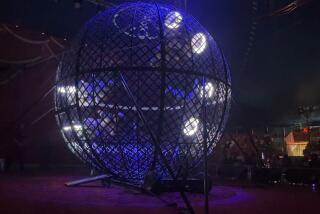Cirque du Soleil leaps into new era, aims to land in China with help from ‘Avatar’
In the climax of “Toruk,” the new Cirque du Soleil show inspired by the 2009 James Cameron blockbuster “Avatar,” a Na’vi adolescent with blue skin and a thrashing tail learns to conquer his failures as a warrior to become the first of his clan to tame a flying toruk — a giant winged predator — and save his people from catastrophe.
Can Cirque pull off a similar comeback story? As it seeks to catapult out of a financially difficult period, the 32-year-old Montreal company finds itself at a strategic crossroads as it transitions beyond its signature big-top spectacles and Las Vegas extravaganzas and into new growth opportunities — namely, partnering more with established entertainment properties like “Avatar” and expanding into China.
It’s a far cry from the quirky troupe of street performers founded in 1984 in the small Quebec town of Baie-Saint-Paul. One member, a fire-breather and stilt-walker named Guy Laliberté, saw broader potential and dubbed the company Cirque du Soleil, taking it to the U.S. for the first time in 1987 for the Los Angeles Festival. He grew the company into a global brand and, in the process, became a billionaire.
The latest changes at Cirque come in the wake of new ownership. TPG Capital, the San Francisco and Forth Worth-based private equity firm, acquired a 55% stake in Cirque last year, along with the Chinese conglomerate Fosun International, which holds 25%. The $1.4-billion leveraged buyout ended the reign of Laliberté, who retains a 10% share.
Corporate ownership has shifted priorities at the once-idiosyncratic company known for its colorful acrobatics and gravity-defying stunts.
“We are more analytical than we were, which I think is positive,” said Daniel Lamarre, president and chief executive of Cirque, during a recent stop in Los Angeles. “I don’t see making more money as a problem.”
After the buyout, “people thought TPG would come in and say ‘cut, cut, cut,’” he added. “To be totally candid, when I went through this transaction, I was concerned about that.”
But Lamarre said that hasn’t happened, noting that Cirque already went through downsizing in 2013 when it laid off 400 employees, or 8% of its workforce, following a number of high-profile flops, including the early closure of “Iris” in L.A. In the same year, the company experienced a major setback when an aerialist in the Las Vegas show “Ka” fell to her death during a performance.
Cirque has seen major shake-ups in its executive corridors since the buyout. Several longtime veterans — including the company’s chief operating officer, chief financial officer and head of publicity — have left Cirque in the last year.
Its new COO, Jonathan Tétrault, comes from consulting giant McKinsey & Co. and oversees all of Cirque’s shows.
“To enhance growth you need to bring new people to the table,” said David Trujillo, a partner at TPG. At the same time, he said, TPG beefed up Cirque’s marketing department, adding a new executive position that didn’t exist before.
“We have supercharged marketing on social media channels -- something that Cirque hasn’t really done,” he said.
Under TPG, Cirque recently introduced demand-based ticket pricing to its Vegas shows. “It is working. We’re certainly seeing an uplift,” Trujillo said.
TPG also owns a controlling interest in Creative Artists Agency, the Hollywood talent behemoth, and Trujillo sits on the boards of Cirque and CAA. He would like to see the companies work on “licensing the Cirque brand so it’s more well-known out there.”
Cirque remains privately held and doesn’t make its financial results public. A recent Moody’s report stated that Cirque saw weaker-than-expected global revenue of $756 million in 2015, down more than 10% from the previous year.
The company derives about half of its annual revenue from touring shows like “Toruk,” according to Moody’s. The company took on about $885 million in debt and credit commitments as part of the buyout last year.
Cirque is projecting 2016 revenue of $800 million to $1 billion worldwide, Lamarre said.
Some analysts are skeptical.
“I’m more bearish,” said Alina Khavulya, senior analyst at Moody’s. “It’s a company that doesn’t have a history of operating with so much debt. They will have to run a leaner operation. And they have a larger stakeholder base to answer to.”
What’s more, she added: “Private equity doesn’t have much patience for underperformance.”
Lamarre said that Cirque has “always been profitable,” even during its recent downturn. “We never lost money,” he said.
Teaming up with well-known entertainment properties has become a key strategy for Cirque at a time when it faces brand fatigue and saturation of its core Vegas market. It has seven shows there, the oldest being 1993’s “Mystere.”
In many ways, “Toruk” embodies that ambition. The arena show, developed in collaboration with Cameron’s Lightstorm Entertainment, is its first to be based on a movie. It will also be Cirque’s first show in mainland China, when a tour kicks off in 2018.
“Toruk” opened at the Citizens Business Bank Arena in Ontario on Wednesday and will continue there through Sunday. Then it will move to Staples Center in downtown L.A. for shows Nov. 11 to Nov. 13. It will go to cities such as Phoenix, San Diego and Sacramento before returning to the L.A. area Jan. 12 at the Forum.
The show cost more than $30 million to create, Lamarre said. “That’s more than the average touring show. It’s closer to the cost of our permanent shows.”
“We all knew the fit was perfect,” Cameron said in an interview, describing himself as a longtime fan of the company. When creating the Na’vi for the original movie, “I was inspired by the dreamlike indigenous motifs and new languages they make up — the otherworldly exoticism of their shows.”
The filmmaker didn’t direct “Toruk” but served as a consultant. Cirque came up with the idea of creating a prequel to “Avatar,” taking place thousands of years before humans set foot on the moon Pandora.
Lightstorm participated in the development by providing input on the story arc, visual effects, costumes and more, said “Avatar” producer Jon Landau, speaking at at Lightstorm’s offices in Manhattan Beach.
Mostly, “we were there as the stewards of the franchise – the world of ‘Avatar’ and world of Pandora,” Landau said. That meant ensuring continuity between the Cirque show and various “Avatar” properties, which include video games, a coming Disney World attraction and the four big-screen sequels that Cameron is set to direct starting next year.
While the marriage of “Avatar” and Cirque felt natural, other partnerships seem less intuitive at first glance: Cirque is teaming up with the NFL to create a four-story tourist attraction in Times Square that will feature immersive digital exhibits designed to draw visitors into the world of professional football.
“There’s a little misperception that Cirque only does acrobatic shows,” Trujillo of TPG said. Cirque worked on the 2012 Super Bowl halftime show and was featured prominently in this season’s “Dancing With the Stars” on ABC. “If you’re an intellectual property holder, Cirque is the place to go to put it in live form.”
But partnering with famous properties doesn’t guarantee box-office success. While Cirque scored with its shows based on the music of Michael Jackson and the Beatles, its “Viva Elvis” show in Las Vegas closed in 2012 because of weak ticket sales.
Lamarre said Cirque has been working with Disney for two years on a workshop, but didn’t specify the nature of the project.
“We’ve had quite a bit of experience together, which I hope will create a breakthrough,” he said. Cirque’s “La Nouba” has been running at Walt Disney World in Orlando, Fla., since 1998.
Cirque hopes that “Toruk” will serve as a beachhead into the vast Chinese market thanks to the popularity of “Avatar,” which grossed more than $200 million in the country. “China will change the face of Cirque,” Lamarre said.
The company is working on a new permanent show in the eastern city of Hangzhou for 2018, and Lamarre said there is “great potential to have a permanent show in Shanghai and one in Beijing.”
He added that Fosun, the Chinese conglomerate that holds a 25% stake in Cirque, is “bringing an intelligence about the market that I didn’t have.”
In recent years, Fosun has embarked on a buying spree of foreign companies in sectors as varied as real estate, insurance and entertainment. It is a major backer of Studio 8, the film company founded by Jeff Robinov, the former Warner Bros. Pictures Group president. Fosun executives didn’t reply to a request for comment.
“Fosun’s investment strategy is to look at overseas assets that can have a domestic play and synergy with their domestic position,” said Thilo Hanemann, an economist at Rhodium Group, where he researches Chinese investment. “They want to find an asset that they can leverage in China.”
Cirque recently opened its first permanent office in Shanghai. It is also expanding elsewhere in the world.
In May, Cirque launched its first Broadway production, “Paramour,” but the show had a bumpy start when critics gave it negative reviews. It is also entering the theme-park business with a new attraction in Nuevo Vallarta, Mexico, set to open in 2018.
The new ventures expose the company to a lot of risk, but “we cannot be afraid,” Lamarre said. “There’s a distinction between danger and fear. You have to recognize the danger and be humble about that and that’s our attitude.”
More to Read
Inside the business of entertainment
The Wide Shot brings you news, analysis and insights on everything from streaming wars to production — and what it all means for the future.
You may occasionally receive promotional content from the Los Angeles Times.











